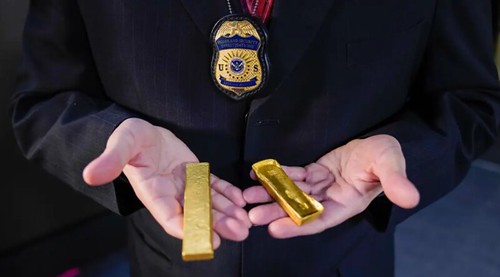
PREV ARTICLE
NEXT ARTICLE
FULL ISSUE
PREV FULL ISSUE
V25 2022 INDEX E-SYLUM ARCHIVE PRINCE DE CONTY GOLD INGOTS RETURNEDI missed getting this one into the last issue. Arthur Shippee forwarded this New York Times piece about gold ingots recently returned to France. -Editor The seas were high and the fog was thick in December 1746 when the Prince de Conty, a French frigate returning home from China with tea, ceramics and roughly 100 gold ingots, foundered in the Atlantic, just 10 miles from shore. Its bounty sank beneath the waves and laid untouched for 228 years until 1974, when treasure hunters located the wreck and illegally scavenged its remains.
On Wednesday, five of the gold ingots, embossed with Chinese characters and valued at $231,000, were returned to the French Embassy in Washington, ending an odyssey of 48 years that involved underwater detectives, international diplomacy and an appearance on Patience, said David R. Keller, a special agent with Homeland Security Investigations who oversaw the American side of the case, is critical when pursuing stolen cultural items as they travel through the marketplace.
Mr. L'Hour believes many of the ingots have been melted down and others remain secreted in what he calls someone's By 1983, French prosecutors had filed charges against more than a dozen people in connection with the shipwreck, yet most of the accused testified that they knew nothing of the ingots. But in 1995, Mr. L'Hour was able to track down a copy of the underwater picture of the ingots taken by one of the divers in 1975. It showed the gold nestled among two sea creatures, a starfish and a sea urchin — useful evidence if the ingots ever surfaced.
Some of them did, in 1999, on an episode of PBS's She said the ingots had come from a different shipwreck off Western Africa, but the accompanying photo she had would later prove to match the one Mr. L'Hour had already acquired. (It, too, showed the ingots beside the starfish and sea urchin, which are indigenous to French, but not African, coastal waters.)
The five ingots would not surface again until 2017, when a Florida woman who had acquired them sometime after their Mr. L'Hour studied a clip of the episode, which was still posted on the PBS website. He noticed right away, he said, that the photo of the ingots presented by the French woman on the show matched the one that had been taken by the diver in 1975. In an affidavit, Mr. L'Hour declared that the French woman, in fact, was the sister of the photographer's wife. Armed with that evidence, in 2018 the French government petitioned American officials to seize the ingots from the auctioneer.
In an interview, Joe Lang, a representative of the auction house, Stephen Album Rare Coins in Santa Rosa, Calif., said, Each bar weighs about 13 ounces, so as a matter of gold, by weight, the five ingots are worth about $125,000 on the precious metals market. But officials said they had increased the estimate of their value because collectors will often pay a premium for ingots recovered from a shipwreck.
To read the complete article, see:
Wayne Homren, Editor The Numismatic Bibliomania Society is a non-profit organization promoting numismatic literature. See our web site at coinbooks.org. To submit items for publication in The E-Sylum, write to the Editor at this address: whomren@gmail.com To subscribe go to: https://my.binhost.com/lists/listinfo/esylum All Rights Reserved. NBS Home Page Contact the NBS webmaster 
|

